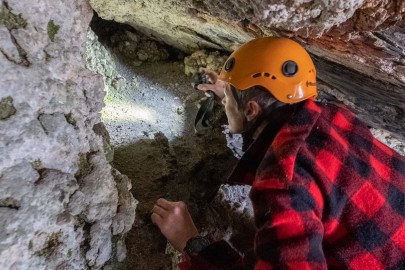Ancient diets revealed by kākāpō scats

Principal Scientist Dr Janet Wilmshurst searches a cave near Lake Wakatipu, Otago, for ancient DNA samples. Image: Brad White.
Kākāpō now depend on the production of rimu fruit to breed, which only happens every two to five years. This breeding cycle creates problems for kākāpō conservation, especially since rimu don’t occur in all of Aotearoa New Zealand’s forests. However, fossils show that in the past, kākāpō were abundant and lived throughout AoNZ. The kākāpō niche must have therefore been much broader in the past than today.
A collaborative effort between Manaaki Whenua, the University of Auckland, and the University of Adelaide, used cutting-edge ancient DNA techniques and microscopic techniques to investigate what plants kākāpō were eating in ancient AoNZ. They did this by looking at kākāpō coprolites (preserved droppings), which have been found in caves across the South Island.
Surprisingly, the research showed that kakapo lived and bred in beech forests and were not purely reliant on rimu masting to survive and breed. The birds ate a wide variety of plants including mistletoes and fungi that are not in their diet today, a direct result of their heavily contracted population now restricted to a handful of managed populations on offshore islands.
“This work has come at a critical time for kākāpō conservation” says Dr Janet Wilmshurst. “The kākāpō population is increasing, and their islands can’t sustain them for much longer. Our work suggests that southern beech leaves and seeds were major kākāpō foods in the past, which is a big surprise since kākāpō hardly ever eat beech today. This means that beech forests are probably ideal habitats for kākāpō.”

